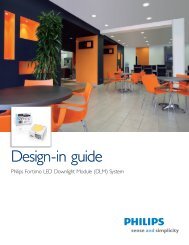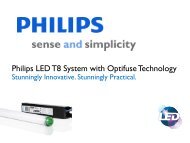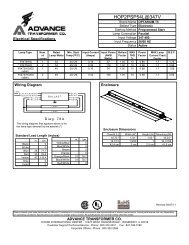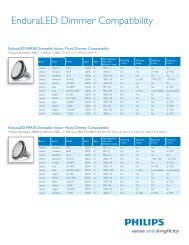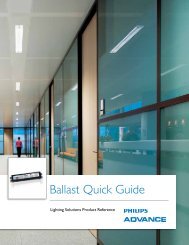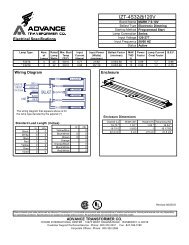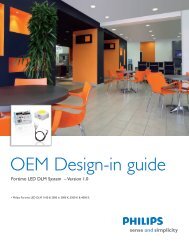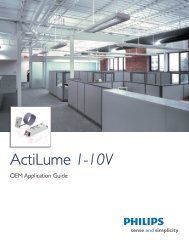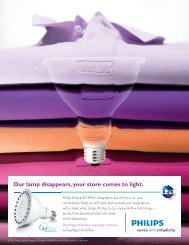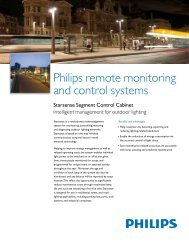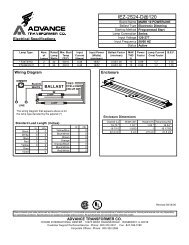Design-in guide - Philips Lighting
Design-in guide - Philips Lighting
Design-in guide - Philips Lighting
Create successful ePaper yourself
Turn your PDF publications into a flip-book with our unique Google optimized e-Paper software.
<strong>Design</strong>-<strong>in</strong> <strong>guide</strong><br />
<strong>Philips</strong> Fortimo LED Twistable Downlight Module (TDLM) Gen 2<br />
1100 lm and 2000 lm 120 VAC modules
Contents<br />
Introduction 3<br />
Information and support 3<br />
Introduction to the Fortimo LED Twistable DLM Module Gen 2 4<br />
Applications 4<br />
Product description 4<br />
Classification 4<br />
About the module 4<br />
Generation 2 5<br />
LEDs power<strong>in</strong>g Fortimo LED Twistable DLM Module Gen 2 6<br />
What is LED? 6<br />
LED packag<strong>in</strong>g 7<br />
B<strong>in</strong>n<strong>in</strong>g 7<br />
Mid-power LED 7<br />
M<strong>in</strong>iaturization 7<br />
Important recommendations and warn<strong>in</strong>gs 8<br />
<strong>Design</strong>-<strong>in</strong> phase 8<br />
<strong>Design</strong>-<strong>in</strong> and manufactur<strong>in</strong>g phase 8<br />
Module replaceability 8<br />
Warn<strong>in</strong>gs 8<br />
Mechanical characteristics 9<br />
Mechanical construction of the Fortimo LED Twistable<br />
DLM Module Gen 2 9<br />
Dimensions of the Fortimo LED Twistable<br />
DLM Module Gen 2 range 9<br />
Dimensions of the BJB lampholders 10<br />
Dimensions of the Stucchi lampholders 10<br />
Dimensions of the Ideal lampholders 11<br />
Light<strong>in</strong>g characteristics 12<br />
Light distribution 12<br />
Optical files 12<br />
Spectral light distribution diagram 1100 lm 13<br />
Spectral light distribution diagram 2000 lm 13<br />
Polar <strong>in</strong>tensity diagram 1100 lm 14<br />
Polar <strong>in</strong>tensity diagram 2000 lm 14<br />
Colour consistency (SDCM) 15<br />
Reflector design 15<br />
Thermal management 16<br />
Operat<strong>in</strong>g temperatures 16<br />
Test requirements 16<br />
Maximum Temperature 16<br />
Critical measurements Tc po<strong>in</strong>t 16<br />
Case temperature 17<br />
Twistable with closed heat s<strong>in</strong>k 17<br />
Twistable with open heat s<strong>in</strong>k 17<br />
Operation under built-<strong>in</strong> conditions 18<br />
Thermal <strong>in</strong>terface 18<br />
Heats<strong>in</strong>k design 18<br />
Thermal Conductivity 19<br />
Emission 19<br />
Thermal de-rat<strong>in</strong>g system 19<br />
Size of heats<strong>in</strong>k & Thermal Interface Material 19<br />
Air flow 20<br />
Thermal model 20<br />
Analogy between electrical and thermal resistance 20<br />
Calculat<strong>in</strong>g your heat s<strong>in</strong>k 21<br />
Available <strong>in</strong>formation 21<br />
Heat s<strong>in</strong>k complementary partners 21<br />
Electrical design 22<br />
Wir<strong>in</strong>g 22<br />
Length of ma<strong>in</strong>s cable 22<br />
Start<strong>in</strong>g characteristics 22<br />
Low and overvoltage 22<br />
Inrush current 2 22<br />
Dimm<strong>in</strong>g 23<br />
Switch<strong>in</strong>g 23<br />
Quality 24<br />
Compliance and approval marks 24<br />
Susta<strong>in</strong>ability 24<br />
Conditions of acceptance 24<br />
IP rat<strong>in</strong>g, humidity and condensation 24<br />
Energy Star 24<br />
Titlke 24 24<br />
EMC 24<br />
Susta<strong>in</strong>ability 25<br />
Dur<strong>in</strong>g operation 25<br />
System disposal 25<br />
Contact Details 25<br />
2 <strong>Design</strong> In Guide <strong>Philips</strong> Fortimo LED Twistable Downlight Module Gen 2
Introduction<br />
Thank you for choos<strong>in</strong>g the <strong>Philips</strong> Fortimo LED Twistable Downlight Module (TDLM)<br />
Gen 2. In this <strong>guide</strong> you will f<strong>in</strong>d the <strong>in</strong>formation required to design this module <strong>in</strong>to a<br />
lum<strong>in</strong>aire, plus valuable h<strong>in</strong>ts and tips.<br />
The product specifications and <strong>in</strong>formation regard<strong>in</strong>g the products <strong>in</strong> this document<br />
are subject to change without notice. All statements, <strong>in</strong>formation, and recommendations<br />
<strong>in</strong> this document are believed to be accurate but are presented “as-is”. Without any<br />
representations or warranties of any k<strong>in</strong>d, express or implied.<br />
This <strong>guide</strong> is presented solely for <strong>in</strong>formational purposes. Users take full responsibility<br />
for their application of any products.<br />
This <strong>guide</strong> is designed solely for use by eng<strong>in</strong>eers, light<strong>in</strong>g designers and other<br />
professional with<strong>in</strong> the light<strong>in</strong>g <strong>in</strong>dustry only.<br />
Information and support<br />
This <strong>guide</strong> tells you all about this system.<br />
If you require any further <strong>in</strong>formation or support please consult your local <strong>Philips</strong> office<br />
or please consult your <strong>Philips</strong> account representative.<br />
The advantages of LEDs have been known for 40 years:<br />
• Energy Efficient – uses less power (w) than conventional light<strong>in</strong>g<br />
• Long life – low ma<strong>in</strong>tenance cost<br />
• Robustness – high reliability<br />
• Saturated colors – maximum visual effect<br />
• Cool beam – no heat<strong>in</strong>g of illum<strong>in</strong>ated products<br />
• No UV or IR – wide application possibilities<br />
• Low-voltage operation – more safety, ease of use<br />
• Mercury-free – care for the environment<br />
The use of LEDs has implications for light<strong>in</strong>g manufacturers <strong>in</strong> terms of differences <strong>in</strong><br />
solid-state light<strong>in</strong>g usage compared with traditional lamps: for example how to design<br />
given the constant improvements <strong>in</strong> specifications: how to provide the necessary heat<br />
s<strong>in</strong>k and how to deal with variations <strong>in</strong> flux and/or color. The <strong>Philips</strong> Fortimo LED<br />
Twistable Downlight Module addresses these differences and facilitates easy adoption of<br />
LED technology for the lumen packages, 1100 lm to 2000 lm.The system is designed for<br />
<strong>in</strong>tegration <strong>in</strong> lum<strong>in</strong>aires. This technical application <strong>guide</strong> addresses the relevant issues to<br />
support and facilitate the work of specifiers and light<strong>in</strong>g system designers.<br />
<strong>Design</strong> In Guide <strong>Philips</strong> Fortimo LED Twistable Downlight Module Gen 2 3
Introduction to the Fortimo LED Twistable<br />
Downlight Module (TDLM) Gen 2<br />
Applications<br />
<strong>Philips</strong> Fortimo LED Twistable Downlight Module Gen 2 has been primarily designed for<br />
<strong>in</strong>door applications but may, <strong>in</strong> certa<strong>in</strong> circumstances, be used <strong>in</strong> certa<strong>in</strong> damp location<br />
(provided all applicable laws and regulations are followed, <strong>in</strong>clud<strong>in</strong>g UL 1598).<br />
The <strong>Philips</strong> Fortimo LED TDLM, as the name suggests, is designed and <strong>in</strong>tended for<br />
general downlight <strong>in</strong> accordance with North American lum<strong>in</strong>aire standard, UL 1598.<br />
TDLM 1100 lm Module<br />
1<br />
Examples of applications <strong>in</strong>clude:<br />
• Hospitality (hotels representative areas such as receptions, boardrooms,<br />
restaurants, etc.)<br />
• Cruise ships (corridors, cab<strong>in</strong>s)<br />
• Public build<strong>in</strong>gs (schools, c<strong>in</strong>emas, theaters, exhibition halls)<br />
• Office (Corridors, reception/lobbies, wait<strong>in</strong>g area)<br />
• Urban outdoor light<strong>in</strong>g (ground light<strong>in</strong>g, post-top lanterns)<br />
• Retail (corridors, general wait<strong>in</strong>g area, dress<strong>in</strong>g room area, mall facades)<br />
Product description<br />
To operate a system the follow<strong>in</strong>g products are needed:<br />
• A <strong>Philips</strong> Fortimo LED TDLM Module Gen 2<br />
• A heats<strong>in</strong>k (sold separately)<br />
• A reflector (depend<strong>in</strong>g on the application) (sold separately)<br />
• Lampholder (sold separately)<br />
TDLM 2000 lm Module<br />
Classification<br />
The <strong>Philips</strong> Fortimo LED Twistable Downlight Module Gen 2 can be used <strong>in</strong>:<br />
• Non Class 2 system (lum<strong>in</strong>aire heat s<strong>in</strong>k must be grounded)<br />
• Neither the <strong>Philips</strong> Fortimo LED Twistable Downlight Module Gen 2 nor its<br />
lampholder can be used for wet location applications. So if an OEM decides to use<br />
the system <strong>in</strong> a lum<strong>in</strong>aire for outdoor applications, the OEM is solely responsible<br />
for relevant approbation design as well as compliance with any and all laws,<br />
standards and regulations.<br />
About the module<br />
The protective hous<strong>in</strong>g allows easy handl<strong>in</strong>g dur<strong>in</strong>g transport and <strong>in</strong>stallation. It<br />
also protects the LEDs from direct access/damage once mounted, and ensures the<br />
appropriate safety distance between the LEDs and any metal objects (for example<br />
a reflector). The connector allows quick and easy <strong>in</strong>stallation and replacement of<br />
the module.<br />
4 <strong>Design</strong> In Guide <strong>Philips</strong> Fortimo LED Twistable Downlight Module Gen 2
Generation 2<br />
<strong>Philips</strong> is cont<strong>in</strong>uously improv<strong>in</strong>g its Fortimo products.<br />
The second generation of the Fortimo LED Twistable Downlight Modules has been<br />
developed to enable LED adoption and upgrades very easily. The range aimed at energy<br />
efficiency has a very good Total Cost of Ownership and is easy to <strong>in</strong>stall. There is no<br />
tra<strong>in</strong><strong>in</strong>g and tool<strong>in</strong>g required result<strong>in</strong>g <strong>in</strong> low ma<strong>in</strong>tenance thus reduced runn<strong>in</strong>g costs<br />
over the lifetime of the lum<strong>in</strong>aire.<br />
This range changed from remote phosphor to white LEDs to help deliver better<br />
efficiency. The quality of LEDs does not require the phosphor plate anymore. The<br />
modules will cont<strong>in</strong>ue to ensure the same high quality.<br />
F<strong>in</strong>ally, the 1100 lumen module is Zhaga 1 certified, the full range of TDLMs will be Zhaga<br />
certified from Q2-2013 onwards.<br />
<strong>Philips</strong> Fortimo Twistable Module types<br />
The range of Twistable Gen 2 Modules<br />
Fortimo LED TDLM 1100 827 120V G2<br />
Fortimo LED TDLM 1100 830 120V G2<br />
Fortimo LED TDLM 1100 835 120V G2<br />
Fortimo LED TDLM 2000 827 120V G2<br />
Fortimo LED TDLM 2000 830 120V G2<br />
Fortimo LED TDLM 2000 835 120V G2<br />
Note: Lampholder for both 1100 lm module and 2000 lm module are available at our<br />
complementary partners BJB and Ideal Industries.<br />
Note: 277 volt and 4000K CCT Modules will be available later <strong>in</strong> 2013<br />
<strong>Design</strong> In Guide <strong>Philips</strong> Fortimo LED Twistable Downlight Module Gen 2 5
LEDs power<strong>in</strong>g Fortimo LED Twistable<br />
Downlight Module Gen 2<br />
The development of Light Emitt<strong>in</strong>g Diodes (LEDs) is progress<strong>in</strong>g at such a pace that they<br />
are rapidly ga<strong>in</strong><strong>in</strong>g a majority of use for light<strong>in</strong>g applications. To most people, the term<br />
LED still only means the small <strong>in</strong>dicator lights that show whether the TV set is switched<br />
on. These t<strong>in</strong>y light sources barely emit enough light to make themselves visible. In the<br />
Fortimo LED Twistable Downlight Module Gen 2 system, multi-die white LEDs are used.<br />
This package enables high efficiency, high lumens, and m<strong>in</strong>imum CRI of 80. 3<br />
What is LED?<br />
LEDs are solid-state devices, built up from crystall<strong>in</strong>e layers of semiconductor material.<br />
The light generation process makes use of the special electronic properties of crystall<strong>in</strong>e<br />
semiconductors <strong>in</strong> a process called <strong>in</strong>jection lum<strong>in</strong>escence.<br />
In brief, this means the <strong>in</strong>jection of charged particles by an electric field from one<br />
semiconductor layer <strong>in</strong>to another, where they are able to relax to a lower- energy state<br />
by emitt<strong>in</strong>g visible light. LEDs produce narrow light spectra. The bandwidth rema<strong>in</strong>s<br />
limited to a few tens of nanometers, and is therefore perceived by the human eye as a<br />
s<strong>in</strong>gle, deeply saturated color. LEDs are now available <strong>in</strong> all wavelengths of the visible<br />
spectrum; yellow is the only region <strong>in</strong> which no high-power LED is currently available.<br />
White light can be produced by comb<strong>in</strong><strong>in</strong>g LEDs of different colors (for <strong>in</strong>stance red,<br />
green and blue), or by apply<strong>in</strong>g phosphor coat<strong>in</strong>gs on blue or ultraviolet LEDs. Like many<br />
other lamps, LEDs cannot be connected directly to the ma<strong>in</strong>s. The LEDs have to be<br />
operated at a stabilized low voltage, which is provided by driver electronics.<br />
However, LEDs do not need ignition and can be switched on/off with<strong>in</strong> milliseconds.<br />
LEDs do not generate nearly as much heat as many other lamps, but that does not mean<br />
that thermal design is not important. LEDs do produce heat when they operate, and are<br />
themselves relatively sensitive to temperature. Thermal considerations are therefore<br />
very important aspects of lum<strong>in</strong>aire design that <strong>in</strong>corporates LEDs.<br />
6 <strong>Design</strong> In Guide <strong>Philips</strong> Fortimo LED Twistable Downlight Module Gen 2
LED packag<strong>in</strong>g<br />
The bare LED die is still a very sensitive and fragile device that must be handled <strong>in</strong> a<br />
clean room environment. Before br<strong>in</strong>g<strong>in</strong>g them outside, they must be packaged. The<br />
light flux of conventional LEDs, for example those used as <strong>in</strong>dicator lights on TV sets,<br />
is severely limited by the amount of heat generated. In practice, conventional LED<br />
packages are limited to about 0.15 W at most, and emit only a few lumens. The LEDs<br />
used <strong>in</strong> Fortimo LED Twistable Downlight Module Gen 2 are middle power s<strong>in</strong>gle-die<br />
packaged, composed of blue dies with phosphor.<br />
B<strong>in</strong>n<strong>in</strong>g<br />
The subject of b<strong>in</strong>n<strong>in</strong>g should be expla<strong>in</strong>ed because of its importance <strong>in</strong> LED system<br />
design. As <strong>in</strong> other semiconductor manufactur<strong>in</strong>g processes, <strong>in</strong> LED production the<br />
number of parameters of the epitaxial process is very large and the process w<strong>in</strong>dow<br />
small (for example, the temperature must be controlled to with<strong>in</strong> 0.5 °C (
Important recommendations and warn<strong>in</strong>gs<br />
Warn<strong>in</strong>gs<br />
• Follow <strong>in</strong>stallation rules explicitly<br />
• Inspect each product before <strong>in</strong>stallation<br />
• Do not <strong>in</strong>stall damaged LED modules<br />
The follow<strong>in</strong>g recommendations and warn<strong>in</strong>gs should be followed dur<strong>in</strong>g the various<br />
phases of use of the Fortimo LED Twistable Downlight Module Gen 2:<br />
<strong>Design</strong>-<strong>in</strong> phase<br />
Lum<strong>in</strong>aire manufacturers must conform to the <strong>in</strong>ternational standards for lum<strong>in</strong>aire<br />
design (UL/CSA1598- lum<strong>in</strong>aires).<br />
<strong>Design</strong>-<strong>in</strong> and manufactur<strong>in</strong>g phase<br />
• Do not use damaged or defective contacts or hous<strong>in</strong>gs.<br />
• Ensure proper heat management to help guarantee the lifetime of the module.<br />
Module replaceability<br />
The module can be easily replaced without deconnect<strong>in</strong>g the ma<strong>in</strong>s<br />
8 <strong>Design</strong> In Guide <strong>Philips</strong> Fortimo LED Twistable Downlight Module Gen 2
Mechanical characteristics<br />
Mechanical construction of the Fortimo LED Twistable Downlight Module Gen 2<br />
The module can operate by us<strong>in</strong>g the ma<strong>in</strong> components below:<br />
• Fortimo LED TDLM Gen 2<br />
• Lampholder<br />
Note: the Fortimo LED Twistable Downlight Module Gen 2 1100 lm module and<br />
respective lampholders are Zhaga compliant 1<br />
Dimensions of the Fortimo LED Twistable Downlight Module Gen 2 range<br />
(dimensions <strong>in</strong> mm)<br />
Twistable Gen 2 1100 lm Top view<br />
Twistable Gen 2 2000 lm Top view<br />
Twistable Gen 2 1100 lm side view<br />
Twistable Gen 2 2000 lm side view<br />
Note: at the backside of each Fortimo LED Twistable Downlight Module Gen 2, you’ll f<strong>in</strong>d<br />
thermal <strong>in</strong>terface material for optimal thermal contact to a heats<strong>in</strong>k. Important: Do not<br />
remove the thermal pad.<br />
Twistable Gen 2 1100 lm top view<br />
Twistable Gen 2 2000 lm top view<br />
<strong>Design</strong> In Guide <strong>Philips</strong> Fortimo LED Twistable Downlight Module Gen 2 9
Mechanical characteristics<br />
Note: Optical w<strong>in</strong>dow is same for both modules (1100 and 2000 lm).<br />
Dimensions of the BJB lampholders<br />
(dimensions <strong>in</strong> mm)<br />
Dimensions of the Stucchi lampholders<br />
(dimensions <strong>in</strong> mm)<br />
Twistable TDLM Module Gen 2 Twistable DLM Module Gen 2<br />
1100 lm – BJB 1100 lm – Stucchi<br />
Twistable DLM Module Gen 2 Twistable DLM Module Gen 2<br />
2000 lm – BJB 2000 lm – Stucchi<br />
10 <strong>Design</strong> In Guide <strong>Philips</strong> Fortimo LED Twistable Downlight Module Gen 2
Dimensions of the Ideal lampholders (dimensions <strong>in</strong> mm)<br />
1100lm<br />
2000lm<br />
Assemble the lampholder on your heats<strong>in</strong>k with 3 M3 screws<br />
<strong>Design</strong> In Guide <strong>Philips</strong> Fortimo LED Twistable Downlight Module Gen 2 11
Light<strong>in</strong>g characteristics<br />
Light distribution<br />
The light distribution of the Fortimo TDLM is near lambertian and can be used for a<br />
multitude of applications. The light distribution can best be controlled us<strong>in</strong>g a specular/<br />
near-specular reflector.<br />
Optical files<br />
On the <strong>Philips</strong> website (www.philips.com/ledmodulesna) optical files can be downloaded<br />
<strong>in</strong> the follow<strong>in</strong>g formats: IES, <strong>in</strong>clud<strong>in</strong>g a file with Ray-sets.<br />
Photometric files can be used to check the modules far-field <strong>in</strong>tensity distribution.<br />
The <strong>in</strong>itial reflector or lum<strong>in</strong>aire design can be carried out us<strong>in</strong>g a lambertian emitter<br />
to ga<strong>in</strong> simulation speed. The f<strong>in</strong>al design should always be verified us<strong>in</strong>g a simulation<br />
executed with a rayset for the Fortimo Twistable Downlight Module.<br />
Spectral light distribution diagram 1100 lm module<br />
Spectral light distribution diagram 2000 lm module<br />
12 <strong>Design</strong> In Guide <strong>Philips</strong> Fortimo LED Twistable Downlight Module Gen 2
Spectral light distribution diagram 1100 lm module<br />
Spectral light distribution diagram 2000 lm module<br />
<strong>Design</strong> In Guide <strong>Philips</strong> Fortimo LED Twistable Downlight Module Gen 2 13
Light<strong>in</strong>g characteristics<br />
Polar <strong>in</strong>tensity diagram 1100 lm<br />
Polar <strong>in</strong>tensity diagram 2000 lm<br />
Note: TDLM Gen 2 can be operated at a max of 65C at the Tc po<strong>in</strong>t and ma<strong>in</strong>ta<strong>in</strong><br />
specified light output. TDLM Gen 2 can be operated at a max of 70C at the Tc po<strong>in</strong>t, but<br />
14 <strong>Design</strong> In Guide <strong>Philips</strong> Fortimo LED Twistable Downlight Module Gen 2
will result <strong>in</strong> 2% light loss.<br />
Color consistency (SDCM)<br />
The target specification of the <strong>Philips</strong> Fortimo LED Twistable TDLM Module Gen 2<br />
range for colour consistency is with<strong>in</strong> 4 SDCM 2 ellipse <strong>in</strong>side ANSI quadrangle. SDCM<br />
stands for Standard Deviation of Color Match<strong>in</strong>g and the value 4 refers to the size of an<br />
ellipse around the black body locus.<br />
Note: <strong>Philips</strong> ma<strong>in</strong>ta<strong>in</strong>s a tolerance of ± 0,005 on x, y color po<strong>in</strong>ts measurements.<br />
This figure shows color targets for the different color temperatures of the Fortimo<br />
LED Twistable Downlight Module Gen 2 Modules. These are specified <strong>in</strong> the operat<strong>in</strong>g<br />
conditions (Tc 65 °C). In the application a color shift is possible if the Tc temperature is<br />
significantly lower than <strong>in</strong> these targets.<br />
Reflector design<br />
The reflector design can be done by the OEM or can be supplied by a<br />
complementary partner.<br />
If the OEM wants to design its own reflector, raysets can be downloaded from the<br />
Fortimo website (www.philips.com/ledmodules). If more support is needed, please<br />
contact the key account manager or your local <strong>Philips</strong> sales representative.<br />
Different reflector suppliers have designed a reflector that fits the <strong>Philips</strong> Fortimo<br />
LED Twistable Downlight Module Gen 2; Jordan, ACL, Alux Luxar and NATA. These<br />
<strong>Design</strong> In Guide <strong>Philips</strong> Fortimo LED Twistable Downlight Module Gen 2 15
Thermal management<br />
companies can be contacted via their website.<br />
The critical thermal management po<strong>in</strong>ts for the module and driver are set out <strong>in</strong> this<br />
chapter <strong>in</strong> order to facilitate the design-<strong>in</strong> of Fortimo LED Twistable Downlight Module<br />
Gen 2. Keep<strong>in</strong>g these thermal po<strong>in</strong>ts <strong>in</strong> m<strong>in</strong>d will help to ensure optimal performance<br />
and lifetime of the system.<br />
Operat<strong>in</strong>g temperatures – Def<strong>in</strong>itions<br />
• Module temperature: temperature measured on the Tc po<strong>in</strong>t of the module<br />
• Ambient temperature: temperature outside the lum<strong>in</strong>aire<br />
Temperature test po<strong>in</strong>t at bottom PCB<br />
Module Type 1100 lm 2000 lm<br />
Max Tcase 70 °C (all CCTs) 70 °C (all CCTs)<br />
Max Thermal Power at thermal <strong>in</strong>terface @ 2700 K 10.6W 19.1W<br />
Max Thermal Power at thermal <strong>in</strong>terface @ 3000 K 9.7 W 18.5W<br />
Max Thermal Power at thermal <strong>in</strong>terface @ 3500 K 9.7W 18.4W<br />
Tambient 45°C 45°C<br />
Test requirements<br />
The test results of T case and T ambient case of the Module <strong>in</strong> open air or <strong>in</strong> the<br />
standard wooden box will give different results. The worst case test is the wooden box<br />
with T ambient 45 ºC.<br />
Temperature measurements should only be performed when the lum<strong>in</strong>aire is thermally<br />
stable, which may take 0.5 to 2 hours depend<strong>in</strong>g on the thermal capacity of the<br />
lum<strong>in</strong>aire. For all measurements such as temperature, lum<strong>in</strong>ous flux and power, a<br />
stabilization period of at least half an hour must be allowed before any reliable data can<br />
be obta<strong>in</strong>ed. Measurements must be performed by means of thermocouples that are<br />
firmly glued to the surface (and not, for example, secured with adhesive tape).<br />
Maximum Temperature<br />
Because LEDs are temperature-sensitive, LED modules require a different approach<br />
with respect to the maximum permissible component temperature. This is different than<br />
most other types of light sources. Some of the LED modules have a shut down circuit<br />
when temperature becomes to high.<br />
The Fortimo LED Twistable Downlight Module Gen 2 has no shut down circuit and<br />
therefore requires proper thermal design.<br />
Critical measurements Tc po<strong>in</strong>t<br />
For LEDs the junction temperature is the critical factor for operation. S<strong>in</strong>ce there is a<br />
direct relation between the case temperature and the LED junction temperature it is<br />
sufficient to measure the bottom side of the module. The critical po<strong>in</strong>t is on the back<br />
surface of the LED module. If the case temperature (Tc) at the critical measurement<br />
po<strong>in</strong>t is too high (exceed<strong>in</strong>g 70°C), the performance of the LEDs will be adversely<br />
affected, for example <strong>in</strong> terms of light output, lifetime or lumen ma<strong>in</strong>tenance.<br />
16 <strong>Design</strong> In Guide <strong>Philips</strong> Fortimo LED Twistable Downlight Module Gen 2
Case temperature<br />
To ensure the performance and to enable temperature measurement <strong>in</strong> a lum<strong>in</strong>aire,<br />
a Tcase po<strong>in</strong>t has been def<strong>in</strong>ed at the back surface on the Fortimo Twistable Downlight<br />
Module Gen 2.<br />
Module with closed heat s<strong>in</strong>k<br />
Where to pay attention?<br />
• Tcase can be measured on the heat s<strong>in</strong>k, either by mak<strong>in</strong>g a v-groove <strong>in</strong> the<br />
heat s<strong>in</strong>k (Tcase 1) OR mak<strong>in</strong>g a drill hole <strong>in</strong> the heat s<strong>in</strong>k (Tcase 2) (glu<strong>in</strong>g the<br />
thermocouple-wire to the heat s<strong>in</strong>k is strongly recommended).<br />
• The Thermal Interface Material (TIM) stays on the twist and makes thermal contact<br />
with the heat s<strong>in</strong>k.<br />
Module with open heat s<strong>in</strong>k<br />
Where to pay attention?<br />
• Tcase can be measured on the heat s<strong>in</strong>k, by mak<strong>in</strong>g a v-groove <strong>in</strong> the heat<br />
s<strong>in</strong>k (Tcase 1) (glu<strong>in</strong>g the thermocouple-wire to the heat s<strong>in</strong>k is strongly<br />
recommended).<br />
• The Thermal Interface Material (TIM) stays on the twist and makes thermal contact<br />
with the heat s<strong>in</strong>k.<br />
<strong>Design</strong> In Guide <strong>Philips</strong> Fortimo LED Twistable Downlight Module Gen 2 17
Thermal management<br />
Operation under built-<strong>in</strong> conditions<br />
The heat produced by LED module <strong>in</strong> the lum<strong>in</strong>aire (or similar hous<strong>in</strong>g) must be<br />
dissipated to the surround<strong>in</strong>gs. If a lum<strong>in</strong>aire is physically <strong>in</strong>sulated by a ceil<strong>in</strong>g, wall<br />
or <strong>in</strong>sulation blanket, the heat produced cannot easily be dissipated. This will result <strong>in</strong><br />
heat<strong>in</strong>g of the LED module <strong>in</strong> the lum<strong>in</strong>aire, which <strong>in</strong> turn can have an adverse effect on<br />
system performance and lifetime. For optimum performance and lifetime it is important<br />
that: air can flow freely around the lum<strong>in</strong>aries; and airflow through the lum<strong>in</strong>aire, around<br />
the modules, has a positive effect on temperature control and hence on performance<br />
and lifetime.<br />
Thermal <strong>in</strong>terface<br />
In the Fortimo LED the thermal <strong>in</strong>terface is already attached on the module.<br />
Do not remove the thermal <strong>in</strong>terface material.<br />
Heats<strong>in</strong>k design<br />
To ensure that hous<strong>in</strong>g temperatures do not exceed the specified maximum values, a<br />
lum<strong>in</strong>aire can act as an additional heat s<strong>in</strong>k. The applicable heat transport mechanisms<br />
are conduction via the heat s<strong>in</strong>k and convection and thermal radiation to the<br />
surround<strong>in</strong>gs. The objective of this chapter is not to <strong>in</strong>dicate exactly how to calculate<br />
a heat s<strong>in</strong>k, but to give some <strong>guide</strong>l<strong>in</strong>es on how to improve its performance. Although<br />
a heat s<strong>in</strong>k can have many (complex) shapes, the follow<strong>in</strong>g discussion is based on a<br />
disk type of heat s<strong>in</strong>k. The results for square plates, etc., may be similar provided the<br />
surface areas are equal. The type of material used has a relatively large <strong>in</strong>fluence on<br />
the f<strong>in</strong>al result. For example, a comparison of the thermal conductivity (k) of copper<br />
with that of corrosion- resistant steel (see table left) shows that a substantially smaller<br />
heat s<strong>in</strong>k can be made with copper. In practice the best material for heat s<strong>in</strong>ks is (soft)<br />
alum<strong>in</strong>um. The thickness (d) of the heat s<strong>in</strong>k disk is also of major importance. Assum<strong>in</strong>g<br />
the use of different heat s<strong>in</strong>ks of the same diameter but made from different materials,<br />
the same effect <strong>in</strong> terms of temperature difference will be achieved if the product of<br />
thermal conductivity (k) and disk thickness (d) is constant. This means a similar result<br />
is obta<strong>in</strong>ed with a disk of 1 mm copper, 2 mm alum<strong>in</strong>um, 4 mm brass, 8 mm steel or 26<br />
mm corrosion-resistant steel. Increas<strong>in</strong>g the diameter, and thereby also the surface area,<br />
of the heat s<strong>in</strong>k disk also leads to an improvement, but the effect is smaller for larger<br />
diameters and depends on the thermal conductivity (k) of the material and the thickness<br />
(d).Thermal radiation can also form a substantial part of the total heat transfer, and is of<br />
the same order as for convection. This depends strongly on the emission coefficient of<br />
the surface, which lies between 0 and 1. For example, a polished alum<strong>in</strong>um surface has<br />
a very low emission coefficient, while that of a pa<strong>in</strong>ted surface is very high. For passive<br />
cool<strong>in</strong>g, high emission coefficient is preferred.<br />
18 <strong>Design</strong> In Guide <strong>Philips</strong> Fortimo LED Twistable Downlight Module Gen 2
Thermal Conductivity<br />
Material<br />
W/mK<br />
Copper 400<br />
Alum<strong>in</strong>ium 200<br />
Brass 100<br />
Steel 50<br />
Corrosion-resistant steel 15<br />
Emission<br />
Material Surface Emission coefficient<br />
Alum<strong>in</strong>ium New/polished 0.04 – 0.06<br />
Oxidized 0.2 – 0.3<br />
Anodized 0.8<br />
Steel Pa<strong>in</strong>ted 0.8 – 0.95<br />
New/Polished 0.03 – 0.07<br />
Heavy oxidized 0.7 – 0.8<br />
Thermal de-rat<strong>in</strong>g system<br />
The Fortimo LED Twistable Downlight Module Gen 2 has no shutdown circuit and<br />
therefore requires proper thermal design.<br />
Size of heats<strong>in</strong>k & Thermal Interface Material (TIM)<br />
The module conta<strong>in</strong>s a built-<strong>in</strong> heat spreader. The module must be connected to the<br />
heat s<strong>in</strong>k with a thermal <strong>in</strong>terface material (TIM) <strong>in</strong> between which makes sure of a<br />
perfect contact between the module and the heat s<strong>in</strong>k. The module has a thermal power<br />
that needs to be taken away. The spreader at the back of the module is the contact<br />
area for the external heat s<strong>in</strong>k. The performance (life time and amount of light) of the<br />
module depends heavily on the thermal management. Therefore the temperature of the<br />
test po<strong>in</strong>t (Tc) is important. Dur<strong>in</strong>g the thermal design process, the aim is to keep the<br />
Tc temperature at the stated range. Thermal Interface Materials (TIM) are thermally<br />
conductive materials, which are applied to <strong>in</strong>crease Thermal contact conductance<br />
across jo<strong>in</strong>ted solid surfaces, such as between microprocessors and heats<strong>in</strong>ks, <strong>in</strong> order<br />
to <strong>in</strong>crease thermal transfer efficiency. Without a TIM the heat that is generated by<br />
the module cannot be managed effectively by the heat s<strong>in</strong>k. This will result <strong>in</strong> poor<br />
performance or total failure of the module or fixture.<br />
Please note that <strong>in</strong> an assembly scenario where metal screws are not used to fix the<br />
heat s<strong>in</strong>k to the module, then a non-isolated thermal <strong>in</strong>terface material (also known as<br />
electrically conductive TIMs) must be used to ensure proper ground<strong>in</strong>g.<br />
<strong>Design</strong> In Guide <strong>Philips</strong> Fortimo LED Twistable Downlight Module Gen 2 19
Thermal management<br />
Air flow<br />
Before start<strong>in</strong>g with any calculation, an important po<strong>in</strong>t to consider is the airflow. In<br />
general hot air is mov<strong>in</strong>g upwards with relatively low speed. The form and position of<br />
the heat s<strong>in</strong>k is <strong>in</strong>fluenc<strong>in</strong>g the airflow. If the f<strong>in</strong>s are perpendicular to the airflow which<br />
reduces the efficiency of the heat s<strong>in</strong>k. This situation should be avoided.<br />
A better way to position the f<strong>in</strong>s is to have the f<strong>in</strong>s parallel to the airflow direction.<br />
Clos<strong>in</strong>g the top of the profile will reduce the efficiency of the heat s<strong>in</strong>k as well, and<br />
should be avoided dur<strong>in</strong>g design and <strong>in</strong>stallation.<br />
Thermal model<br />
Standard STATIC thermal situations can be modelled with so-called thermal resistances.<br />
These resistances behave like electrical resistors. Below the analogy between electrical<br />
and thermal resistors is expla<strong>in</strong>ed. Where on the left the electrical units are mentioned,<br />
on the right the thermal equivalent is set. With a known voltage difference at a certa<strong>in</strong><br />
current it is possible to calculate an electrical resistor with Ohm’s law. The same is<br />
possible with a thermal resistor. If the temperature difference and the thermal power is<br />
known, the thermal resistance can be calculated with thermal Ohm’s law.<br />
Analogy between electrical and thermal resistance<br />
Thermal model<br />
20 <strong>Design</strong> In Guide <strong>Philips</strong> Fortimo LED Twistable Downlight Module Gen 2
Calculat<strong>in</strong>g your heat s<strong>in</strong>k<br />
We start with a thermal calculation formula:<br />
Formula (f1) the relation between temperature difference, thermal power and thermal<br />
resistance. With this formula the needed thermal resistance can be calculated when the<br />
thermal power and temperature difference are known.<br />
Formulas:<br />
Thermal: Δ T = Rth x Pth (f1)<br />
Next we gather all available <strong>in</strong>formation, as can be found <strong>in</strong> the datasheet, application<br />
details and design choices.<br />
Below we calculate the needed thermal resistance of the heat s<strong>in</strong>k, such that <strong>in</strong> typical<br />
situations, the typical temperature of the test po<strong>in</strong>t Tc, is below its maximum.<br />
Available <strong>in</strong>formation<br />
Tc-max = 70ºC<br />
Pth- Twistable DLM 2000 lm, 3000 K = 19.1 W<br />
Tambient-max <strong>in</strong> application = 50ºC<br />
Below we show an example of how to calculate the needed thermal resistance of the<br />
heat s<strong>in</strong>k, such that <strong>in</strong> worst case situations, the maximum temperature of the test po<strong>in</strong>t<br />
Tc, is below its maximum.<br />
Calculation of total maximum thermal resistance: (f1)<br />
ΔT - Tlmb = 70 – 45 = 25ºC<br />
Rth = ΔT / Pth = 25/19 = 1.31 K/W<br />
Now we know the thermal resistance of the needed heat s<strong>in</strong>k. This heat s<strong>in</strong>k dimension<br />
is such that at maximum power and maximum ambient temperature claimed by the<br />
lum<strong>in</strong>aire makers, the temperature of the test po<strong>in</strong>t Tc should be below 70°C. This<br />
assures that lifetime, color temperature, and light output will be accord<strong>in</strong>g to specifications.<br />
The heat s<strong>in</strong>k dimension can be smaller if the lum<strong>in</strong>aire maker claims a Tambient-max less<br />
than 45ºC. Calculation would be carried out accord<strong>in</strong>g to a similar methodology.<br />
Interested <strong>in</strong> the heats<strong>in</strong>k complementary partners:<br />
Three of the heats<strong>in</strong>k partners that have been work<strong>in</strong>g with <strong>Philips</strong> are Nuventix,<br />
AVC, and Sunon. All three have made heats<strong>in</strong>ks specifically for Fortimo LED Twistable<br />
Downlight Modules accord<strong>in</strong>g to the reference heats<strong>in</strong>k design from <strong>Philips</strong>.<br />
The follow<strong>in</strong>g are suggestions of products that can be used with certa<strong>in</strong> <strong>Philips</strong> Fortimo<br />
LED Twistable Downlight Modules. References to these products does not constitute<br />
their endorsement by <strong>Philips</strong>. <strong>Philips</strong> makes no warranties regard<strong>in</strong>g these products and<br />
assumes no legal liability or responsibility for loss or damage result<strong>in</strong>g from the use of<br />
the <strong>in</strong>formation here<strong>in</strong>.<br />
• www.avc.com.tw<br />
• www.nuventix.com<br />
• www.sunoueurope.com<br />
<strong>Design</strong> In Guide <strong>Philips</strong> Fortimo LED Twistable Downlight Module Gen 2 21
Electrical design<br />
Wir<strong>in</strong>g<br />
The ma<strong>in</strong>s supply cale must be connected to the lampholder.<br />
The earth connector needs to be connected to the heats<strong>in</strong>k/lum<strong>in</strong>aire because the<br />
Fortimo LED Twistable Downlight Module Gen 2 is specified as class I.<br />
The lampholder is screwed with 3x M3 metal screws to the heats<strong>in</strong>k.<br />
In an assembly scenario where metal screws are not used to fix the heat s<strong>in</strong>k to the<br />
module, then a non-isolated thermal <strong>in</strong>terface material (also known as electrically<br />
conductive TIMs) must be used to ensure proper ground<strong>in</strong>g.<br />
Length of ma<strong>in</strong>s cable<br />
The length of the ma<strong>in</strong>s supply cable from the module is approximately 25 cm. The<br />
length of the extension cable outside of the lum<strong>in</strong>aire is not specified.<br />
Start<strong>in</strong>g characteristics<br />
The system can be switched on <strong>in</strong> milliseconds, which is a general characteristic<br />
of LED based systems. Unlike conventional CFL’s, there is no observable<br />
start up time.<br />
Low and overvoltage<br />
The modules can withstand a voltage fluctuation of +/- 10% with no safety<br />
issue and no abnormal early failures.<br />
Inrush current<br />
The current that flows dur<strong>in</strong>g the very first few milliseconds when switch<strong>in</strong>g on a<br />
lum<strong>in</strong>aire or an entire light<strong>in</strong>g <strong>in</strong>stallation is called the <strong>in</strong>rush current. This current<br />
is very important when mak<strong>in</strong>g the right choice of switch gear and fus<strong>in</strong>g, e.g. circuit<br />
breakers, m<strong>in</strong>iature circuit breakers (MCB). The <strong>in</strong>rush current is determ<strong>in</strong>ed <strong>in</strong> part by<br />
the circuitry <strong>in</strong> use and <strong>in</strong> part by the properties of the ma<strong>in</strong>s supply, viz. the ma<strong>in</strong>ssupply<br />
impedance and the supply-cable resistance. The moment of switch<strong>in</strong>g <strong>in</strong> relation<br />
to the s<strong>in</strong>e wave of the supply voltage also determ<strong>in</strong>es the value of the <strong>in</strong>rush current.<br />
The highest <strong>in</strong>rush current is when the driver is connected to the ma<strong>in</strong>s at the peak of<br />
the ma<strong>in</strong>s voltage.<br />
22 <strong>Design</strong> In Guide <strong>Philips</strong> Fortimo LED Twistable Downlight Module Gen 2
Product Ma<strong>in</strong>s <strong>in</strong>put power (W) Inrush current (A) Half time value (µs)<br />
Twist 1100 lm 16.5 1.52 45<br />
Twist 2000 lm 29.5 2.0 50<br />
Product B16 B10 C16 C10<br />
Twist 1100 lm 40 40 40 40<br />
Twist 2000 lm 40 38 40 38<br />
Recommended maximum number of modules to be connected to a circuit breaker type<br />
Note: Numbers could slightly differ depend<strong>in</strong>g on the circuit breaker and amount of<br />
modules <strong>in</strong>stalled on a circuit breaker.<br />
Dimm<strong>in</strong>g<br />
The <strong>Philips</strong> Fortimo LED Twistable Downlight Module Gen 2 is lead<strong>in</strong>g edge dimmable.<br />
Please contact your <strong>Philips</strong> sales representative for the most up-to-date dimmer<br />
compatibility list.<br />
Switch<strong>in</strong>g<br />
The maximum number of switch<strong>in</strong>g cycles at each case temperature up to which the<br />
modules reaches B10L0 at 35khrs:<br />
Max. cycles to B10L0 Twist NAM 1100lm Twist NAM 2000lm<br />
Tcase=70C 4000-4500 3500-4000<br />
Tcase=65C 6000-6500 5000-5500<br />
Tcase=55C 10000-12000 8500-9500<br />
Notes: <strong>Philips</strong> ma<strong>in</strong>ta<strong>in</strong>s a tolerance of ± 6.5% on lum<strong>in</strong>ous flux, ± 2% on CRI<br />
measurements and ± 5% on CCT measurements.<br />
<strong>Design</strong> In Guide <strong>Philips</strong> Fortimo LED Twistable Downlight Module Gen 2 23
Quality<br />
Compliance and approval marks<br />
The <strong>Philips</strong> Fortimo LED Twistable Downlight Module Gen 2 is UL/CSA-approved.<br />
To ensure lum<strong>in</strong>aire approval, the conditions of acceptance need to be fulfilled.<br />
Module-related data can be found <strong>in</strong> UL1993. All lum<strong>in</strong>aire manufacturers are advised<br />
to conform to the <strong>in</strong>ternational standards of lum<strong>in</strong>aire design (UL1598-Lum<strong>in</strong>aires).<br />
Susta<strong>in</strong>ability<br />
The <strong>Philips</strong> Fortimo LED Twistable Downlight Module Gen 2 is RoHS compliant. 4<br />
Conditions of acceptance<br />
Details can be requested from your local sales representative.<br />
IP rat<strong>in</strong>g, humidity and condensation<br />
The Fortimo LED Twistable Downlight Module systems are build-<strong>in</strong> systems and<br />
therefore have no IP classification. They are not designed for operation <strong>in</strong> the open air.<br />
The OEM is responsible for proper IP classification and approbation of the lum<strong>in</strong>aire.<br />
The module has been developed and released for use <strong>in</strong> damp locations and not for<br />
locations where condensation is present.<br />
Warn<strong>in</strong>gs<br />
If there is a possibility that condensation<br />
could come <strong>in</strong>to contact with the modules,<br />
the system/lum<strong>in</strong>aire builder must take<br />
precautions to prevent this.<br />
Energy Star<br />
The product is listed <strong>in</strong> “The Certified Light<strong>in</strong>g Subcomponent Database” on Energy<br />
Star Website. The l<strong>in</strong>k is below:<br />
http://www.energystar.gov/<strong>in</strong>dex.cfm?c=light<strong>in</strong>g.pr_light<strong>in</strong>g_subcomponents<br />
California Title 24<br />
The product is far more efficient than what is required <strong>in</strong> California Title 24. With<br />
proper optical design at lum<strong>in</strong>arie level, the lum<strong>in</strong>arie will meet California Title 24. 5<br />
EMC<br />
Electromagnetic compatibility, EMC, is the ability of a device or system to operate<br />
satisfactorily <strong>in</strong> its electromagnetic environment without caus<strong>in</strong>g unacceptable<br />
<strong>in</strong>terference <strong>in</strong> practical situations. The module was tested <strong>in</strong> a reference lum<strong>in</strong>aire and<br />
no issues were observed.<br />
24 <strong>Design</strong> In Guide <strong>Philips</strong> Fortimo LED Twistable Downlight Module Gen 2
Susta<strong>in</strong>ability<br />
Warn<strong>in</strong>gs<br />
Cautions relat<strong>in</strong>g to use dur<strong>in</strong>g storage,<br />
transportation and operation. If this<br />
product is stored for a long time (more<br />
than one week), it should be stored <strong>in</strong> a<br />
dark place. Do not expose it to sunlight.<br />
The temperature should be ma<strong>in</strong>ta<strong>in</strong>ed at between -40 ~ +65 °C, and RH 5-95%.<br />
Dur<strong>in</strong>g operation<br />
<strong>Philips</strong> shall not be held responsible for any damage to the user aris<strong>in</strong>g from an<br />
accident or any other cause dur<strong>in</strong>g operation of the system if the absolute maximum<br />
rat<strong>in</strong>gs are exceeded.<br />
System disposal<br />
We recommend that the Fortimo LED Twistable Downlight Module and its components<br />
are disposed of <strong>in</strong> an appropriate way at the end of their (economic) lifetime. The<br />
modules are <strong>in</strong> effect normal pieces of electronic equipment conta<strong>in</strong><strong>in</strong>g components<br />
that are currently not considered to be harmful to the environment. We therefore<br />
recommend that these parts are disposed of as normal electronic waste, <strong>in</strong> accordance<br />
with all applicable federal, state and local laws and regulations.<br />
Other<br />
The product has not been evaluated for use with emergency exits.<br />
Contact Details<br />
For specific questions on our products, please contact our regional team.<br />
Footnotes:<br />
1 Philipe Fort<strong>in</strong>o LED Twistable Downlight Module is a Zhaga certified light eng<strong>in</strong>e. For more <strong>in</strong>formation<br />
visit www.zhagestandard.org.<br />
2 All production units fall betweem =/-0.2%<br />
3 +/- 3% variance with all CRI above 80<br />
4 Restrictions on Hazardous Substances (RoHS) is a European directive (2002/95/EC) designed to limit the<br />
content of 6 substances [lead, mercury, cadmium, hexavalent chromium, polybrom<strong>in</strong>ated biphenyls (PBB), and<br />
polybrom<strong>in</strong>ated diphenyl ethers (PBDE)] <strong>in</strong> electrical and electronic products For products used <strong>in</strong> North<br />
America compliance to RoHS is voluntary and self-certified<br />
5 Please refer to http://www.energy.ca.gov/title24/ for the latest requirements.<br />
<strong>Design</strong> In Guide <strong>Philips</strong> Fortimo LED Twistable Downlight Module Gen 2 25
26 <strong>Design</strong> In Guide <strong>Philips</strong> Fortimo LED Twistable Downlight Module Gen 2
<strong>Design</strong> In Guide <strong>Philips</strong> Fortimo LED Twistable Downlight Module Gen 2 27
© 2013 <strong>Philips</strong> Light<strong>in</strong>g Electronics North America<br />
A Division of <strong>Philips</strong> Electronics North America Corporation<br />
All rights reserved.<br />
Pr<strong>in</strong>ted <strong>in</strong> the USA<br />
Form No. LE-6400-B<br />
<strong>Philips</strong> Light<strong>in</strong>g Electronics N.A.<br />
10275 West Higg<strong>in</strong>s Road<br />
Rosemont, IL 60018<br />
Tel: 800-322-2086 Fax: 888-423-1882<br />
Customer Support/Customer Care: 800-372-3331<br />
OEM Support: 866-915-5886<br />
www.philips.com/ledmodulesna



